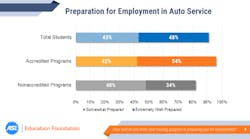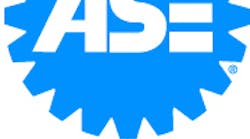The ASE Education Foundation recently conducted an Automotive Career Survey to gain an understanding of current and graduated student opinions of ASE training and certification, and to understand job placement after completion of training in automotive, collision and medium/heavy duty truck programs in the U.S.
ASE invited 157,804 current students and graduates to complete the survey, sent in three separate formats. A total of 2,760 current students and 1,946 graduates responded to the survey.
Outlook for current students
Of the current student respondents, 83 percent were between the ages of 15 and 19, and 12 percent were between the ages of 20 and 24. The highest education level breakdown for current students was as follows: 49 percent were high school graduates, 25 percent had a two-year college degree, and 17 percent attended a technical school. Another 9 percent completed four years of college.
The results were broken out by accredited and non-accredited educational programs. The first important indicator was the question “Do you intend to pursue a career in automotive service technology?” (It is important to note that in the survey “automotive” in this question refers to transportation training and not just light duty vehicles.) For this question, 59 percent of students in accredited programs stated “definitely,” compared to only 37 percent in non-accredited programs. Of the students surveyed, just over one quarter advised they would “probably” pursue an automotive service career. Another 20 percent said they have no plans to pursue a career in automotive service.
The responses to the question “How well do you think your training program is preparing you for employment?” raised an eyebrow for me (see Fig. 1). While nearly half of students believe they are “extremely well prepared,” 43 percent indicated they were only “somewhat prepared.” What does that mean? My take on this is that many students, especially those in non-accredited programs, are just not sure of their ability. Does this translate into students seeking other professions and/or career tracks?
Students were also asked “Have you participated in a work-based program?” – which includes programs such as internships or apprenticeships. Work-based learning programs are critical and provide students with an increased understanding of the industry and the occupation first-hand. Only 35 percent of accredited programs did not have students engaged in some form of work-based learning, while over half of non-accredited students did not participate.
For schools that do not have active work-based learning programs, it may indicate these programs are not involved with their local industry and may not have an active advisory committee. Not having exposure to real-world work environments with these programs may contribute to the technician shortage. For each program that is not engaged with industry, those students (which in some cases could be 20 or more annually) may never get the opportunity to experience the workplace environment and benefits.
When it comes to opinions on ASE certification testing, 83 percent of students believed their school offered testing. Of those respondents, 84 percent indicated they had passed one or more of the tests. Sixty-six percent of accredited student respondents said ASE certification was “extremely important” to their advancement in automotive service, and another 24 percent stated it was “somewhat important.” Nearly half of non-accredited student respondents indicated ASE certification was “extremely important” to their advancement in the field, with another quarter saying it was “somewhat important.” This is a good sign that schools and students are taking and passing the student certification test and that they find value in ASE certification.
Feedback from graduates
Of the 1,946 graduates who responded to the survey, 38 percent were within the 15 to 19 age range, 42 percent were between 20 and 24 years old. For highest education level completed, 35 percent completed high school, 29 percent completed a two-year college, and 32 percent attended a tech school.
The graduates were asked “In which of the following types of jobs are you currently employed?” (See Fig. 2)
This outcome is different from those surveyed as students and there seems to be a significant jump in both “Non-accredited” and “Other” categories. The survey also revealed that 55 percent of both accredited and non-accredited graduates were “Very Satisfied” with their career decision.
At first glance this may lead you to believe the schools and industry are doing a good job preparing and engaging these graduates. But, the survey also revealed that 42 percent of graduates surveyed are no longer in the automotive service industry (See Fig. 3).
Of those no longer in the industry, 18 percent entered technical trades, and another 14 percent are in the retail/food service field. They are leaving our industry and going somewhere else. Some of that could be the starting pay. It would be interesting to see the breakdown of which transportation fields – automotive, collision or medium/heavy duty truck – are seeing the most displaced from their original training into another field.
From what I’ve seen across the country, starting pay in the truck/diesel industry is very good, compared to other segments with lower starting wages. Another interesting point: 11 percent indicated they pursued other school or training and another 10 percent are unemployed.
This information makes the case that other industries are stealing our talent. There are many occupations that don’t have training programs at the high school or college level to train the skills and occupation they serve. For them, the next best thing is to find schools and programs that teach similar skill sets they need, and recruit and hire those students away from their original occupation pathway. HR folks and staffing agencies are getting more creative as the pool of qualified individuals shrinks.
We need to really look at this information and better understand what is happening. We need to ask ourselves, “Are these students-now-graduates trained properly when they are hired into our organization? Do they get lost or thrown to the wolves and asked to do tasks they are not ready for? Do we expect them to instantly produce? Do we on-board them in our company and shop culture?
When asked “How well did your education prepare you for an automotive service career?" (See Fig. 4), 46 percent of accredited graduates said they were “extremely well prepared” compared to just 36 percent of non-accredited graduates. When you look at those numbers, and the number of grads who did not stay in the industry (42 percent), this should raise concerns. Maybe they tried to enter and may have even secured employment but weren’t able to keep it. Or, because their skills may have been limited, they weren’t able to earn the income they expected or needed.
What can we, as an industry, do?
It is up to us as an industry to change these numbers and find ways to increase the number of students and graduates engaged and employed. If you and others in your company are not involved with any transportation programs in your community, it’s time to start.
We all need to look in the mirror and ask, “What am I doing to engage, encourage and support students and programs and provide support?” Consider options such as joining an advisory committee, providing students shadowing at your business or hiring students in internships, apprenticeships or work-based learning activities. Students need to have an increased understanding of what is expected of them, they need to have a mentor onboard them into a shop’s culture and they need guidance to the point they feel ready.
In the end, the numbers don’t support the belief that this generation is not taking “Vocational” courses and they are not interested in the transportation industry. It is just the opposite; there are a large number of students taking the courses at all levels of education. By taking these courses they have made a commitment to us. We now need to be committed to them and ensure them they made the right choice, by guiding them to a path of success in our shops and facilities. We owe it to them.
George Arrants is the training consultant for K&D Technical Innovations. As an automotive education consultant specializing in National Automotive Technicians Education Foundation (NATEF)/ASE Accreditation, Arrants works with instructors and administrators to develop partnerships with local business and industry through program advisory committees. He chairs the Technology and Maintenance Council’s TMCSuperTech – the National Technician Skills Competition – and the TMCFutureTech – the National Student Technician Competition. His entire career has been in the automotive service and education industries.




